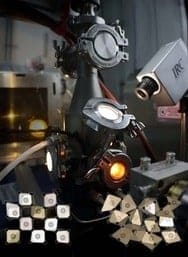A new discovery about the atomic structure of uranium dioxide will help scientists select the best computational model to simulate severe nuclear reactor accidents.
Using the Advanced Photon Source (APS), a Department of Energy (DOE) Office of Science User Facility, researchers from DOE’s Argonne National Laboratory and Brookhaven National Laboratory, along with Materials Development, Inc., Stony Brook University, and Carnegie Institution of Washington, found that the atomic structure of uranium dioxide (UO2) changes significantly when it melts.
UO2 is the primary fuel component in the majority of existing nuclear reactors, but little is known about the molten state because of its extremely high melting point. Until now, the extremely high temperature and chemical reactivity of the melt have hindered studies of molten UO2. This lack of fundamental information has made it difficult to evaluate issues associated with the interaction of molten UO2 with a reactor’s zirconium cladding and steel containment vessel.
The research team found that when uranium dioxide melts, the number of oxygen atoms around uranium changes from eight-fold to a mixture of six- and seven-fold, which changes the way it interacts with other materials. Many existing models, however, do not account for this change in structure or the rapid oxygen dynamics that occur at high temperatures.
“Determining the behavior of UO2 under extreme conditions is essential to enhancing our understanding of reactor safety during severe accidents,” said Mark Williamson of Argonne’s Chemical Sciences and Engineering Division.
“Very few places in the world have the capability to safely measure the structure of molten UO2 at 3,000 degrees Celsius without introducing contamination from the container that holds the melt,” added Chris Benmore of Argonne’s X-ray Science Division.
Researchers studied the UO2 in the hot crystalline and molten states. In this experiment, researchers relied on the APS’s high-energy synchrotron X-ray beam to study a bead of UO2 that was aerodynamically levitated on a stream of argon and heated with a laser beam.
X-ray experiments were performed at sector 11-ID-C at the APS.
The work was funded by the DOE Office of Science (Office of Basic Energy Sciences), the DOE Small Business Innovation Research program and the Argonne Laboratory Directed Research and Development program.
The paper, “Molten uranium dioxide structure and dynamics,” is published in Science magazine. To view the paper, visit the Science website.
“Our group plans to continue to use innovative synchrotron techniques to study molten materials like this,” said John Parise, who holds a joint appointment with Brookhaven National Laboratory and Stony Brook University. “The next steps include putting molten materials under different atmospheres, and that requires modifications to the existing set-up used at APS.”
Parise said this group of researchers, which includes colleagues from Materials Development, Inc., who built the apparatus used to study UO2, is discussing designs for next-generation levitation devices that could be installed at the X-Ray Powder Diffraction beamline at Brookhaven’s National Synchrotron Light Source II, for example.
“There’s a lot more work to be done,” Parise said. “It’s important to understand how many other materials behave in a molten state. Theory is a good way to do that, but theorists need data on how atoms interact with each other in the molten state, under conditions that are as realistic as possible.”
The authors are Lawrie B. Skinner, of Argonne, Stony Brook University and Materials Development, Inc.; Chris J. Benmore, Mark A. Williamson, Andrew Hebden, Thomas Wiencek and Leonard Leibowitz, all of Argonne; Johann K.R. Weber and Oliver L.G. Alderman, of Argonne and Materials Development; Anthony Tamalonis of Materials Development; Malcolm Guthrie, of the Carnegie Institution of Washington; and John B. Parise, of Stony Brook University.
Rick Spence and Douglas Robinson, both of Argonne’s X-ray Science Division, provided technical support and useful discussion.


